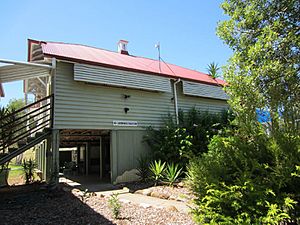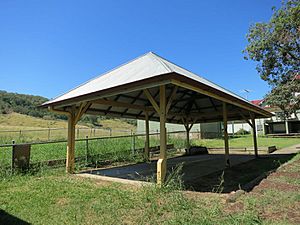Prenzlau State School facts for kids
Quick facts for kids Prenzlau State School |
|
|---|---|

West elevation of 1900 teaching building, 2015
|
|
| Location | 357 Prenzlau Road, Prenzlau, Somerset Region, Queensland, Australia |
| Built | 1899–1900, 1910 |
| Architect | Queensland Department of Public Works |
| Official name: Prenzlau State School | |
| Type | state heritage |
| Designated | 12 June 2015 |
| Reference no. | 602856 |
| Type | Education, research, scientific facility: School-state |
| Theme | Educating Queenslanders: Providing primary schooling |
| Builders | C Ridsdale, Charles Wilson |
| Lua error in Module:Location_map at line 420: attempt to index field 'wikibase' (a nil value). | |
Prenzlau State School is a special school in Prenzlau, Queensland, Australia. It is listed on the Queensland Heritage Register because of its important history. The school was designed by the Queensland Department of Public Works and built between 1899 and 1900. It has been a key part of the local community for many years.
Contents
A Look Back: The School's Journey
Prenzlau State School first opened in 1894 as a "provisional school." This meant it was a smaller school for a growing farming community. It was located in the Lockyer Valley, a beautiful area. As more families moved to Prenzlau, the school became a "state school" in 1899. This meant it was officially run by the government.
Moving to a New Home
In 1923, the school buildings were moved to their current spot. This new location was about 300 meters away. The move made the school better, as the old site was hilly. The school has been open continuously since it first started. It has always been a central place for the community.
Early Days and German Settlers
The land where Prenzlau is located traditionally belongs to the Jagera people. European settlers arrived in the 1840s. The area was first called Back Plains. In the 1870s, German immigrants from a town called Prenzlau in Germany settled here. They named the area Prenzlau in the 1890s.
How Schools Grew in Queensland
Providing education was very important to the government in early Queensland. Laws like the Education Act of 1860 helped set up schools. The State Education Act of 1875 made primary education free and compulsory. This meant most children in Queensland could learn to read and write by 1900. Local communities often helped build schools. They would donate land and even help with the building work. Schools became a symbol of progress and a source of pride.
Building the New School
Because more students were joining, Prenzlau Provisional School became a state school in 1899. A new teaching building was planned. The old provisional school building was turned into a home for the teacher. The new building cost about £618. It was finished in March 1900.
The Queensland Government had standard plans for school buildings. Most were made of timber, which was easy and cheap. These designs were updated over time to improve things like climate control and lighting.
The Main Teaching Building
The main teaching building at Prenzlau State School is a good example of these early designs. It was built with timber and had one large classroom. It had verandahs (covered walkways) at the front and back. There was also a small room at the back for hats and coats. The classroom had special vents in the roof and ceiling to keep it cool. Windows helped let in light.
What is a Playshed?
The education system in Queensland believed that play was important. Since school grounds were often cleared, a covered outdoor space was needed. Playsheds were built as shelters. They had seats and dirt floors. They were used for play and sometimes for teaching.
In 1910, a timber playshed was built at Prenzlau State School. It cost £36.10s. This playshed was a typical design with six posts and a hipped roof. It provided a great space for students to play, especially when there were more than 50 students attending daily.
School Life and Changes Over Time
The Prenzlau area continued to grow. In 1911, there were 27 farmers in Prenzlau. In 1921, the school committee asked for the school to be moved. The old site was too hilly. In 1923, the school building and playshed were moved to the new, flatter site.
When the school moved, it was raised up on timber stumps. This helped with ventilation and created a covered play area underneath. The windows were also made larger to let in more light.
Improvements and Wartime
Over the years, the school had many repairs and improvements. In 1937, the community helped level the ground and improve drainage. During World War II, the school helped the community by acting as a Ration Book Issuing Centre in 1942.
After the war, more improvements were made. A tennis court was built in 1951. On July 31, 1948, an honour board was put up. This board lists the names of people from the area who served in World War II. All those listed were former students of Prenzlau School. Electricity was connected in 1952. The roof was replaced in 1954 after strong winds. A library was added in 1959.
Trees and Gardens at School
Schools in Queensland often planted trees and gardens. This was part of making schools beautiful and teaching students about nature. Arbor Day celebrations, where trees were planted, started in Queensland in 1890.
Prenzlau State School has many old and important trees. An "Anzac" tree was planted at the old school site to remember soldiers. In 1924, native trees like Crow's Ash were planted at the new school. A leopard tree was planted in 1934 to honour the famous pilot, Bert Hinkler. Other trees like coral trees, macadamia, pines, and jacarandas were planted over the years.
Today, you can still see two Crow's Ash trees, a row of Crow's Ash and a She-oak along the western boundary, and one leopard tree. There are also two Jacaranda trees. The school grounds also have 17 Hoop Pine trees from a forestry plot planted between 1970 and 1982.
The School Today
In 1973, there were only 9 students, and the school almost closed. But the community fought to keep it open, saying more children would come. The school stayed open.
In 1994, the school celebrated its 100th birthday. Special entrance gates were put up to mark the occasion.
As of 2025, Prenzlau State School is still open. It uses the original teaching building and playshed. It continues to be a central part of the Prenzlau community, where many generations of students have learned and grown.
What the School Looks Like
Prenzlau State School is located on a 0.92 hectare site in the countryside. The land gently slopes down towards Prenzlau Road. The school buildings are set back from the road, on the highest part of the site.
The Main Teaching Building (1900)
The main teaching building is a timber building raised on concrete stumps. Its walls are made of weatherboards. The front and back verandahs have been enclosed, meaning they are now part of the inside of the building. There's also a small room (annexe) at the back.
The north and south walls have large, old timber windows. The roof is hipped (slopes on all sides) and made of corrugated metal. It has an original metal vent on top to help with airflow. The windows are designed to let in lots of light.
Inside, the walls are lined with wide timber boards. The ceiling is coved (curved) and has special ventilation panels. The World War II honour board hangs on the eastern wall of the classroom.
Underneath the building, there's a concrete floor. This area is partly enclosed with corrugated metal.
The Playshed (1910)
The playshed is a small timber structure with six posts. It has a concrete floor and a hipped roof made of corrugated metal. The posts are supported by brackets. It used to have a wall on one side, but that has been removed.
School Grounds and Views
The school grounds have open lawns, trees, and gardens. The main entrance from Prenzlau Road has a metal archway that says "1894-1994". Many old trees are around the school, including jacaranda, leopard tree, Crow's ash, and she-oak. There's also a group of 17 hoop pine trees.
From the school grounds, you can see beautiful views of the surrounding countryside.
Why is it a Heritage Site?
Prenzlau State School was added to the Queensland Heritage Register on June 12, 2015. This means it's an important historical place.
Showing Queensland's History
The school shows how education in Queensland has changed over time. The teaching building (1900) and the playshed (1910) are great examples of standard government designs. They show how buildings were made to have good lighting and ventilation. The mature shade trees in the grounds are also important.
The World War II Honour Board is important because it shows how the school community was involved in a major world event. Honour boards are a way to remember those who served their country.
Key Features of a Queensland School
Prenzlau State School shows the main features of Queensland state schools. These include:
- Timber buildings built to standard government designs.
- Large, landscaped grounds with old shade trees, play areas, and sports facilities.
It's a good example of a small, local school.
The teaching building (1900) is a great example of a timber school. It still has its hipped roof with a vent, old timber windows, a large classroom with enclosed verandahs, and a coved ceiling. The changes made to the building, like raising it up and making windows bigger, show how ideas about ventilation and lighting improved.
The playshed (1910) still has its hipped timber roof supported by six timber posts.
Strong Community Connection
Schools are very important to Queensland communities. They connect former students, parents, and teachers. They are places for social events and volunteer work. They also represent local progress and hopes for the future.
Prenzlau State School has a strong and lasting connection with the Prenzlau community. It was started in 1894 with help from the local people. Generations of children have been educated here. The school is a key meeting place for social and special events in Prenzlau.
See also
- History of state education in Queensland
- List of schools in West Moreton




